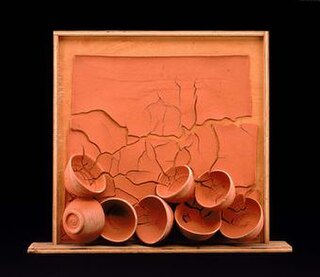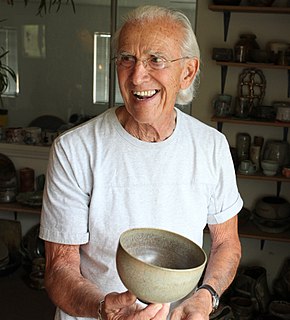
Alfred University is a private university in Alfred, New York. It has a student population of approximately 2,000 undergraduates and 300 graduate students. The institution has five schools and colleges, including the New York State College of Ceramics, which includes The Inamori School of Engineering and the School of Art and Design.

The Alfred Ceramic Art Museum at Alfred University in Alfred, New York, United States houses nearly 8,000 ceramic and glass objects by internationally known ceramic artists. While originally housed in 1,500 sq. ft. of exhibition space in the New York State College of Ceramics' Binns-Merrill Hall, the museum's new building was constructed in 2010 by KMW Architects to allow the museum to grow since the village of Alfred is known as a ceramics mecca.
In American higher education, particular to the state of New York, a statutory college or contract college is a college or school that is a component of an independent, private university that has been designated by the state legislature to receive significant, ongoing public funding from the state. The statutory college is operated by the university on behalf of the state, with the mission of serving specific educational needs of the state. New York's statutory colleges are administratively affiliated with the State University of New York (SUNY) system, and receive funding from SUNY's operating budget. There are five statutory colleges: four located at Cornell University and one located at Alfred University.

Studio pottery is pottery made by professional and amateur artists or artisans working alone or in small groups, making unique items or short runs. Typically, all stages of manufacture are carried out by the artists themselves. Studio pottery includes functional wares such as tableware and cookware, and non-functional wares such as sculpture, with vases and bowls covering the middle ground, often being used only for display. Studio potters can be referred to as ceramic artists, ceramists, ceramicists or as an artist who uses clay as a medium.

Kim Yik Yung, born in 1935 in Chongjin, Hamgyong, is a South Korean ceramic artist.

Jun Kaneko is a Japanese ceramic artist living in Omaha, Nebraska, in the United States. His works in clay explore the effects of repeated abstract surface motifs.
Robert Chapman Turner was an American potter known for his functional pottery, sculptural vessels and inspired teaching.

American craft is craft work produced by independent studio artists working with traditional craft materials and processes. Examples include wood, glass, clay (ceramics), textiles, and metal (metalworking). Studio craft works tend to either serve or allude to a functional or utilitarian purpose, although they are just as often handled and exhibited in ways similar to visual art objects.

Harvey Littleton was an American glass artist and educator, one of the founders of the studio glass movement; he is often referred to as the "Father of the Studio Glass Movement",. Born in Corning, New York, he grew up in the shadow of Corning Glass Works, where his father headed Research and Development during the 1930s. Expected by his father to enter the field of physics, Littleton instead chose a career in art, gaining recognition first as a ceramist and later as a glassblower and sculptor in glass. In the latter capacity he was very influential, organizing the first glassblowing seminar aimed at the studio artist in 1962, on the grounds of the Toledo Museum of Art. Imbued with the prevailing view at the time that glassblowing could only be done on the factory floor, separated from the designer at his desk, Littleton aimed to put it within the reach of the individual studio artist.
D. Wayne Higby is an American artist working in ceramics.
Julia Galloway is a potter who creates utilitarian work, and is a professor and Director of the School of Art at the University of Montana-Missoula.

Charles Fergus Binns was an English-born studio potter. Binns was the first director of the New York State School of Clayworking and Ceramics, currently called the New York State College of Ceramics at Alfred University. He began his position in 1900 and retired in 1931. His work included authorship of several books on the history and practice of pottery. Some of his more notable students included Arthur Eugene Baggs, William Victor Bragdon, R. Guy Cowan, Maija Grotell and Elizabeth Overbeck. This has led Binns to be called "the father of American studio ceramics".
Norm Schulman was an American ceramic artist who lived in Penland, North Carolina. He was born in New York City in 1924. He operated his own studio, Norman Schulman Studio, in Penland.
Edris Eckhardt was an American artist associated with the Cleveland School. She is known for her work in Ceramic art and glass sculpture, her work with the Works Projects Administration's (WPA) Federal Arts Project of Cleveland, and her teaching.

Margaret A Boozer is an American ceramist and sculpture artist, best known for her clay and ceramic compositions, or landscapes, that focus on the individuality, history, and geology of the clay used as subject matters.

Scholes Library is a special academic library located at Alfred University that serves the New York State College of Ceramics, Inamori School of Engineering, as well as for the greater international arts and sciences research community. The library has an extensive collection of materials on ceramic art, science, engineering and technology, as well as extensive holdings in photography, sculpture, art history, glass art, electronic media and other areas of art and design. A Special Collections room houses original theses, rare books and artists' books. Other facilities include a 24-hour study room; an extensive slide library; audiovisual and computer data projection facilities for individual or group use; and original documents and photographs in the archives.
Heather Mae Erickson is an artist, a craftsperson, and a designer. Erickson earned her BFA at The University of the Arts, majoring in crafts specializing in ceramics with a concentration in art education. Continuing her studies at Cranbrook Academy of Art, she earned an MFA in ceramic art.

Donald Lester Reitz was an American ceramic artist, recognized for inspiring a reemergence of salt glaze pottery in United States. He was a teacher of ceramic art at the University of Wisconsin–Madison from 1962 until 1988. During this period, he adapted the pottery firing technique developed in the Middle Ages, which involved pouring salt into the pottery kiln during the firing stage. The method was taught in European ceramic art schools, but largely unknown in United States studio pottery.
Don Schreckengost was an American industrial ceramic designer who was active from the 1930s through the 1990s. He is considered to be the first American industrial ceramic designer.











